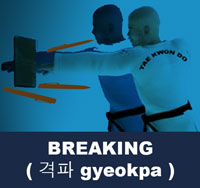Taekwondo 태권도Taekwondo Preschool
When you reach senior belt you are expected to guide the junior belts when they are beginning Taekwondo such as showing by example. To advance from one rank to the next, students typically complete promotion tests in which they demonstrate their proficiency in the various aspects of the art before a panel of judges or their teacher. View Taekwondo belt levels »

Multiple Stacked Boards
Power Break ( 위력격파 )
Breaking is the discipline of destroying inanimate materials such as wooden boards, bats, ice or bricks is a feature common to several Asian martial arts including taekwondo. In breaking competitions, the idea is to demonstrate power, speed and technique. The preferred object is commonly wooden boards of varying thicknesses, advanced students break several boards stacked one on top of the other.
There are two types of multiple stacked board settings: pegged (spaced) and unpegged (unspaced). Unpegged stacks are where multiple items are stacked directly on top of each other.
- Power Break ( 위력격파 )

Training Safety Precautions
There are safety concerns with taekwondo breaking ( 격파 gyeokpa ), so one should seek out a certified Master Instructor ( 사범님 sabeomnim ). There are many small bones of the foot ( 발 bal ) and hand ( 손 son ) which need to be very carefully and slowly conditioned for safety. Repeated damage to the extensor capsules of the knuckles can lead to long term problems with dexterity.
* Please see a certified Master Instructor ( 사범님 sabeomnim ) for training. Proper guidance and instructions are needed to ensure safe training.
Pegged vs Unpegged (Spaced vs Unspaced)
Pegged stacks are stacks where multiple items are stacked with spacing items (often referred to as spacers) between them, usually wood spacers. "Pegged" stacking allows a direct transfer of kinetic energy and the striker must maintain peak force much longer than an "unpegged" stack as the striker moves down through the pile they are encountering the resistance of each board individually instead of creating enough force to flex and break an entire stack unspaced."
This is due to the way in which the two materials break. Wood, which is a natural fibrous matrix, flexes to a certain degree before it snaps at the target point. When unpegged, this allows for an entire stack of wood to flex upon impact, resulting in the break occurring in the order of furthest board from impact to the closest board (albeit a fraction of a second difference separates each board, making it appear instantaneous). This can be witnessed in many novice demonstrations where the rear board will break, but the remaining top boards are intact. When pegged, the gap between the boards necessitates each individual board to flex and snap before the next board is reached in succession. Bricks, on the other hand, are ceramic, and snap (or shatter) upon impact, with no flex action.
When using a pegged design, the setup and positioning of the pegs is critical. Taekwondo competitors work extremely close with their team to ensure that each peg is in proper location and will not shift. A peg that shifts from its location can potentially interfere with the overall break of the stack. If careful consideration and measures are not taken, pegs will typically shift during the initial stack and setting of the break.
Concrete patio blocks, used in most major breaking competitions, require the competitor to "shock" the material and drive through from top to bottom.
Spacing of materials in competition is also important to enable a clear winner to be established as the number of stacked items increases. Whereas a limit of five unspaced patio blocks may be a common sticking point from one competitor to another, a stack of spaced patio blocks can provide more variables because of the increased confidence, which will narrow the field of competitors. This use of spacers makes competition more dynamic and exciting for competitors and spectators alike.

Training Safety Precautions
Usually before the taekwondo class starts, the master ( 사범님 sabeomnim ) instructs the students to jog around the dojang to warmup. Depending on the size of the dojang, several laps are done. Risk of injury can be reduced by completing an effective warm-up consisting of a heart raiser to get your pulse up, followed by sport specific dynamic stretches (stretches whilst moving).
* Please see a certified Master Instructor ( 사범님 sabeomnim ) for training. Proper guidance and instructions are needed to ensure safe training.

Related Articles
Breaking ( 격파 gyeokpa ) is the discipline of destroying inanimate objects such as wooden boards, bats, ice or cement bricks. The preferred object is commonly wooden boards of varying thicknesses, advanced students break several boards stacked one on top of the other. View Breaking ( 격파 gyeokpa ) »
Risk of injury can be reduced by completing an effective warm up consisting of a heart raiser to get your pulse up, followed by sport specific dynamic stretches (stretches whilst moving). Please follow the guidance of a certified Master Instructor or trainer when doing sports related activities. Depending on the intensity of the exercise, cooling down can involve a slow jog or walk, or with lower intensities, stretching can be used. Cooling down allows the heart rate to return to its resting rate. View more information on Warming Up and Cooling Down ».
This article uses material from the Wikipedia articles "Warming Up" and "Cooling Down", which is released under the Creative Commons Attribution-Share-Alike License 3.0.
RESOURCES
This article uses material from the Wikipedia article "Breaking (Martial Arts)" which is released under the Creative Commons Attribution-Share-Alike License 3.0.


















